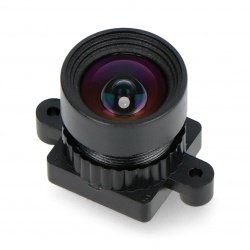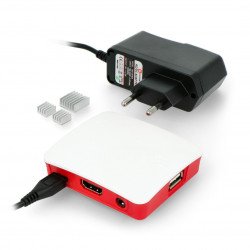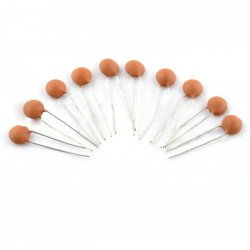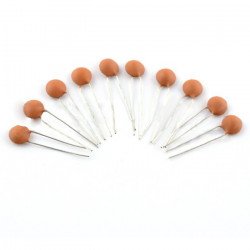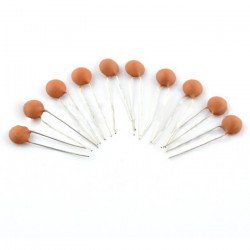THT ceramic capacitors - a capacitor is a passive electronic component. It is made of a conductor separated by a dielectric. A ceramic capacitor is much less sensitive to damage than an equally popular electrolytic capacitor. The store offers a wide range of ceramic capacitors - from the smallest capacitance (6,8 pF) to much larger (470 nF). All components are made using ceramics.
THT ceramic capacitors
Ceramic capacitor 470pF/50V - 1000 pcs.
Through hole ceramic capacitor of 470 pF / 50 V. Price for 1000 pieces.- Reduced price
- SPECIAL OFFERS
Ceramic Condenser 47nF / 50V - 1000pcs
Through hole ceramic capacitor of 47 nF / 50 V. The price is for 1000 pieces.- Sale
- SPECIAL OFFERS
Ceramic capacitor 22nF/50V - 1000 pcs.
Through hole ceramic capacitor of 22 nF / 50 V. The price is for 1000 pieces.Ceramic capacitor 22pF/50V - 1000 pcs.
Ceramic capacitor 22 pF / 50 V. Price per 1000 pieces.Ceramic capacitor 100pF/50V - 1000 pcs.
Through hole ceramic capacitor of 100 pF / 50 V. Price for 1000 pieces.Ceramic capacitor 100nF/50V - 1000 pcs.
Through hole ceramic capacitor of 100 nF / 50 V. The price is for 1000 pieces.Ceramic capacitor 3,3nF/50V THT - 10pcs
Ceramic capacitor 3,3 nF / 50 V . Price for 10 pieces .Ceramic condenser 270pF/50V THT - 10 pcs
Through hole ceramic capacitor of 270 pF / 50 V. Price for 10 pieces.KondCeramic condenser 2,2nF/50V THT - 10pcs
Through hole ceramic capacitor of 2.2 nF / 50 V. The price for 10 pieces.Ceramic condenser 6,8nF/50V THT - 10 pcs
Through hole ceramic capacitor of 6.8 nF / 50 V. The price for 10 pieces.Ceramic condenser 1,5nF/50V THT - 10pcs
Through hole ceramic capacitor of 1,5 nF / 50 V. The price for 10 pieces.Ceramic condenser 330pF/50V THT - 10pcs
Through hole ceramic capacitor of 330 PF / 50 V. Price for 10 pieces.Ceramic condenser 150pF/50V THT - 10pcs
Through hole ceramic capacitor of 150 pF / 50 V. Price for 10 pieces.Ceramic capacitor 10pF/50V THT - 10pcs
Through hole ceramic capacitor of 10 pF / 50 V. The price for 10 pieces.Ceramic capacitor 22pF/50V THT - 10pcs
Through hole ceramic capacitor of 22 pF / 50 V. Price for 10 pieces.Monolithic capacitor 470nF/50V X7R - 10pcs.
The monolithic capacitor 470 nF / 50 V. Pins' pitch: 5 mm. Length with pins: 14 mm. Price for 10 pieces.Monolithic capacitor 1uF/50V X7R - 10pcs
Monolithic capacitor 1 μF / 50 V . Lead-in pattern: 5 mm. Length with leads: 14 mm. Price for 10 pieces.Monolithic capacitor 10nF/50V - 10pcs
10 nF / 50 V monolithic capacitor. Leads pattern: 5 mm. Length with leads: 14 mm. Price for 10 pieces.Ceramic condenser 100nF / 50V THT - 10 pcs.
Through hole ceramic capacitor of 100 NF / 50 V. The price for 10 pieces.THT ceramic capacitors
A ceramic capacitor is made of one or more plates of ceramic materials. The ceramics used offer different properties, depending on the type of material selected. The relative permittivity is from several to several dozen thousand times greater than the permittivity of vacuum. Such high values allow you to build small components whose capabilities can equal those of electrolytic capacitors. A very big advantage of ceramic capacitors is the lack of polarization - this is their greatest advantage over electrolytic capacitors.
Principle of operation and application of ceramic capacitors
The operation of a capacitor can be compared to a buffer that stores energy inside and releases it for a while when it is cut off from the power source. The operation can be better illustrated by an example in which the LED is connected to a battery and the capacitor is mounted in parallel in front of the diode. When the circuit is closed, the diode will light up (and the capacitor will charge). After disconnecting, the diode will not turn off immediately, but only after a few seconds. The reason is to "release" the energy stored in the capacitor. Very often they are used together with coils to build filters to clean the signal or stabilize the voltage. Ceramic capacitors work great in systems where the voltage value can change very often. They are also perfect for use in digital electronics, which is based primarily on the use of microcontrollers. Ceramic capacitors are particularly good at filtering high frequencies. Unfortunately, they cope worse with low frequencies - electrolytic capacitors work exactly the opposite, so it is worth using them together, combining the advantages and eliminating the disadvantages. It is worth remembering that the price of ceramic capacitors is lower than electrolytic capacitors - this information may be important when purchasing larger quantities (e.g. for mass production).
THT ceramic capacitors - FAQ
A ceramic capacitor is a passive electronic element made of a conductor separated by a dielectric. These types of elements are used in almost every electronic device today. A good description of its operation is to compare it to an energy buffer which, after cutting off the power source, will continue to release the stored energy for a few moments.
Ceramic capacitors do not have polarization - only electrolytic capacitors have this. It is worth paying attention to this, because incorrect connection of the electrolytic capacitor will result in complete damage to the element and possibly even an explosion.
Electrolytic capacitors can lose their initial capacity very slowly. Most often, however, this is the result of, for example, leakage in the packaging or difficult conditions in which it worked.
The basic two types of capacitors are electrolytic capacitors and ceramic capacitors. There are also foil and tantalum capacitors. These types of elements can also be distinguished due to their adaptation to different types of assembly - for example, surface mounting (SMD) or through-hole mounting (THT) .









































































































































































































































































































































